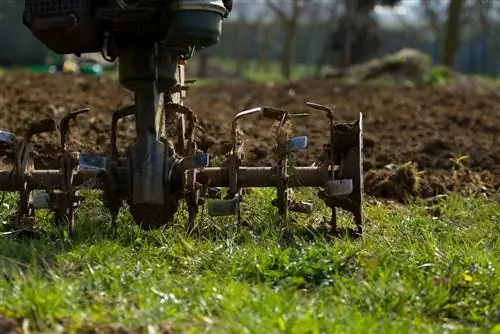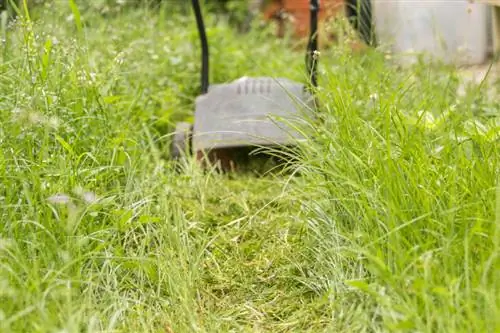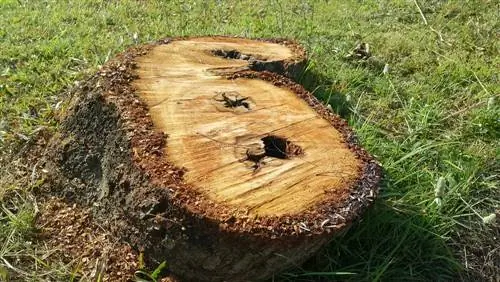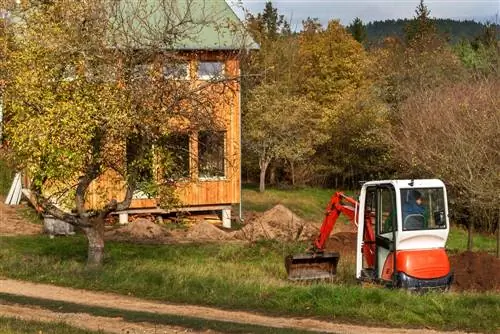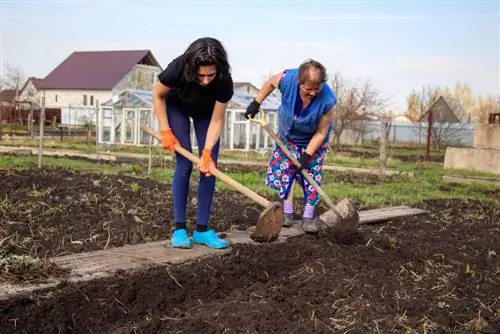- Author admin [email protected].
- Public 2023-12-16 16:46.
- Last modified 2025-01-23 11:21.
It is not always advisable to destroy the old lawn with a milling machine. This measure has disadvantages and is only suitable for certain purposes. Alternatively, gentle interventions are suitable that have less impact on the valuable soil life.

Does digging up a lawn with a tiller make sense?
Digging up a lawn with a tiller is only recommended if the area has strong unevenness or is to be converted into a swamp or horse meadow. Alternatively, there are soil-friendly methods that have less of an impact on valuable soil life.
When milling makes sense
When milling, mosses, grasses and weeds are shredded on the surface. The electrically powered devices loosen the soil at the same time. Powerful milling machines layer the soil to a depth of between 60 and 80 centimeters. Milling is only recommended if the surface has significant unevenness. If you want to convert a lawn into a swamp or horse meadow, this measure also makes sense.
Advantages and disadvantages
Plowing also brings seeds of unwanted plants to the surface of the earth that got into the soil as a result of previous maintenance measures. A fast-growing lawn substitute will prevent these seeds from germinating. The soil structure is disturbed when digging. Special soil organisms live in every layer of the earth and are dependent on the respective conditions. If these conditions are destroyed, the soil needs time to regenerate.
Special caution is required if plants and grasses with rhizomes have spread in your lawn. Couch grass and groundweed develop an extensive root system that is never completely removed from the soil when tilled. There is a risk that root parts will remain in the substrate and sprout again later.
These are the advantages of digging:
- Lawn milling machines save time and energy
- all plants are detached and torn out
- loosening the soil
Alternatives to digging
An old lawn with weak unevenness can be renewed using a soil-friendly method. Spread an opaque tarpaulin over the area and weigh it down with stones. Under the film, photosynthesis comes to a standstill and the old plant population dies. The first successes are visible after six months. It takes up to 24 months for the vegetation under the tarp to completely retreat.
Compensate any unevenness with a mixture of sand and compost. You can then spread a grass seed mixture over the area. When sowing, ensure an even distribution. The seeds must then be pressed so that they come into contact with the ground. Alternatively, rolled turf is suitable for quickly greening the area. This method also offers the advantage that weed seeds cannot germinate under the turf. Thorough watering ensures that the grass carpet grows.
If the lawn is heavily matted, peeling off the turf may make sense. Lawn peelers remove the top layer of soil with a thickness of between five and ten centimeters. All plants are removed along with their roots without any rhizome parts being buried in deeper layers of soil. You can turn the grass pieces 180 degrees and place them back on the surface. This means you maintain the nutrient balance of the soil and do not have to spread new topsoil.

